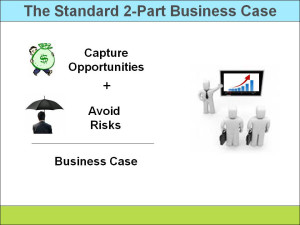7 Risks to Revenue without Sustainability Strategies

“Thanks, but no thanks. Maybe later.”Those words are like the kiss of death to a sustainability champion. Usually the rebuff follows a presentation to a busy executive who is surprisingly unexcited about the financial opportunities the company can capture if it embraces sustainability strategies. Now what?
There are only two reasons a company changes: it wants to capture opportunities and / or it wants to mitigate risks. Convincing a company executive to fully embed sustainability into its strategies and operations therefore requires a compelling two-part business case. As shown in the adjacent figure, this case must include the risks of what might happen if the company does not take action, as well as the benefits it can reap if it does.
The risks bring a sense of urgency to the decision. In a sales situation, we sometimes use the FUD factor — planting seeds of fear, uncertainty, and doubt about what could happen if the proposed solution is not adopted. The risks help show that the status quo is not a viable option. This blog series will provide the FUD factor for the sustainability business case, starting with risks that could erode revenue.
Regulatory and litigation risks are usually top of mind when companies think of sustainability-related risks, and most companies have learned how to avoid or manage them. The new kid on the block — reputation risk — may grow to be the most important for many businesses.
Why? There are seven potential hits to revenue if a company eschews sustainability strategies. Five of them arise from potential brand erosion on environmental footprint issues; one is based on lack of action to mitigate escalating energy, water, and material expenses; and the last is the threat of sudden disruption of the company’s supply chain or access to customers.
- Risk to revenue from poor reputation on energy and carbon management
- Risk to revenue from poor reputation on water management
- Risk to revenue from poor reputation on materials and waste management
- Risk to revenue from poor supplier reputation and behaviors
- Risk to revenue from poor reputation on eco-system damages
- Risk to revenue from less competitive prices
- Risk to revenue from sudden disruptions in the value chain
There are other potential threats, including another seven operating risks, but this is a reasonable cross-sector starter set of risks to the company’s revenue if they decide to take a pass on sustainability strategies. Quantifying the potential impact of these risks supports a comeback to the “Thanks, but no thanks” objection, when you might say, “I understand your hesitancy, but let’s make sure you are also okay with the potential risks of not using these sustainability-related strategies.” An executive’s low appetite for risk may trigger a green light for sustainability strategies, even if the potential opportunity benefits did not.
In upcoming blogs, we will examine each of the seven potential risks to revenue, monetize its potential impact, and factor that amount by the likelihood it will occur within the next three- to five-years. Stay tuned…
As usual, the above slide is from my Master Slide Set.
Please feel free to add your comments and questions using the Comment link below. For email subscribers, please click here to visit my site and provide feedback.
Bob




